Storage Impact on the Physicochemical and Microbiological Stability of Apricot, Cherry, Raspberry, and Strawberry Jams
Abstract
1. Introduction
2. Materials and Methods
2.1. Samples
2.2. Chemicals, Working Standard Solutions, and Culture Media
2.3. Physicochemical Analysis
2.4. Microbiological Analysis
2.5. Statistical Analysis
3. Results and Discussion
3.1. Storage Effects on the pH, Titratable Acidity, and Moisture Content of Fruit Jam Samples
3.2. Storage Effect on Sugar Content of Fruit Jam Samples
3.3. Viscosity Changes During Storage of Fruit Jam Samples
3.4. Color Changes During Storage of Fruit Jam Samples
3.5. Total Number of Yeasts and Molds
3.6. Total Number of Aerobic Mesophilic Germs (TAMG)
3.7. Principal Component Analysis
4. Conclusions
Author Contributions
Funding
Institutional Review Board Statement
Informed Consent Statement
Data Availability Statement
Conflicts of Interest
References
- Mazur, S.P.; Nes, A.; Wold, A.B.; Remberg, S.F.; Martinsen, B.K.; Aaby, K. Effects of ripeness and cultivar on chemical composition of strawberry (Fragaria × ananassa Duch.) fruits and their suitability for jam production as a stable product at different storage temperatures. Food Chem. 2014, 146, 412–422. [Google Scholar] [CrossRef] [PubMed]
- Touati, N.; Tarazona-Díaz, M.P.; Aguayo, E.; Louaileche, H. Effect of storage time and temperature on the physicochemical and sensory characteristics of commercial apricot jam. Food Chem. 2014, 145, 23–27. [Google Scholar] [CrossRef]
- Crops and Livestock Products. Available online: https://www.fao.org/faostat/en/#data/QCL (accessed on 31 January 2025).
- Countries by Commodity. Available online: https://www.fao.org/faostat/en/#rankings/countries_by_commodity (accessed on 31 January 2025).
- Singh, N.; Karimullah, S.N.S.; Chandra, S. Physico-chemical Evaluation of the Squash prepared from different Varieties of Peach. Biol. Forum-Int. J. 2023, 15, 28–35. [Google Scholar]
- Trademap Country Sel Product. Available online: https://www.trademap.org/Country_SelProduct.aspx (accessed on 31 January 2025).
- Apricot Jam Export Import Data, Buyers & Suppliers List. Available online: https://www.volza.com/p/apricot-jam/import/ (accessed on 31 January 2025).
- Market for Jam, Jelly, Puree and Paste in European Union. Available online: https://app.indexbox.io/report/200791h200799/155/ (accessed on 31 January 2025).
- Naeem, M.M.; Fairulnizal, M.M.; Norhayati, M.K.; Zaiton, A.; Norliza, A.H.; Syuriahti, W.W.; Mohd Azerulazree, J.; Aswir, A.R.; Rusidah, S. The nutritional composition of fruit jams in the Malaysian market. J. Saudi Soc. Agric. Sci. 2017, 16, 89–96. [Google Scholar] [CrossRef]
- Digiesi, S.; Facchini, F.; Silvestri, B. Green strategies to reduce the environmental impact of jam production. Transp. Res. Procedia 2022, 67, 72–82. [Google Scholar] [CrossRef]
- Hashim, H.; Aisha, A.M.; Modu, S. Preparation and Nutritional Evaluation of Enriched Jam Made from Blends of Apple, Strawberry and Grapes. Fudma J. Sci. 2024, 8, 238–243. [Google Scholar]
- Alexa, E.; Lalescu, D.; Berbecea, A.; Camen, D.; Poiana, M.A.; Moigradean, D.; Bala, M. Chemical composition and antioxidant activity of some apricot varieties at different ripening stages. Chil. J. Agric. Res. 2018, 78, 266–275. [Google Scholar]
- Alajil, O.; Sagar, V.R.; Kaur, C.; Rudra, S.G.; Sharma, R.R.; Kaushik, R.; Verma, M.K.; Tomar, M.; Kumar, M.; Mekhemar, M. Nutritional and Phytochemical Traits of Apricots (Prunus Armeniaca L.) for Application in Nutraceutical and Health Industry. Foods 2021, 10, 1344. [Google Scholar] [CrossRef]
- Filimon, R.V.; Beceanu, D.; Niculaua, M.; Arion, C. Study on the anthocyanin content of some sour cherry varieties grown in Iaşi area, Romania. Agron. Res. Mold. 2011, 1, 81–91. [Google Scholar] [CrossRef][Green Version]
- Serradilla, M.J.; Akšić, M.F.; Manganaris, G.A.; Ercisli, S.; González-Gómez, D.; Valero, D. Fruit chemistry, nutritional benefits and social aspects of cherries. In Cherries: Botany, Production and Uses; CABI: Wallingford, UK, 2017; pp. 420–441. [Google Scholar]
- Borowy, A.; Chrzanowska, E.; Kapłan, M. Comparison of three sour cherry cultivars grown in central-eastern Poland. Acta Sci. Pol. Hortorum 2018, 17, 63–73. [Google Scholar] [CrossRef]
- Serradilla, M.J.; Hernández, A.; López-Corrales, M.; Ruiz-Moyano, S.; Córdoba, M.G.; Martín, A. Composition of the cherry (Prunus avium L. and Prunus cerasus L.; Rosaceae). In Nutritional Composition of Fruit Cultivars; Simmonds, M.S.J., Preedy, V.R., Eds.; Academic Press: London, UK, 2016; pp. 127–147. [Google Scholar]
- Blando, F.; Oomah, B.D. Sweet and sour cherries: Origin, distribution, nutritional composition and health benefits. Trends Food Sci. Technol. 2019, 86, 517–529. [Google Scholar] [CrossRef]
- Sokół-Łętowska, A.; Kucharska, A.Z.; Hodun, G.; Gołba, M. Chemical composition of 21 cultivars of sour cherry (Prunus cerasus) fruit cultivated in Poland. Molecules 2020, 25, 4587. [Google Scholar] [CrossRef] [PubMed]
- Reyes-Manríquez, S.; Yuri, J.A.; Neira, A.; Fuentes, M.; Palma, M.; Moya, M.; Sánchez-Contreras, J. Biochemical characterization of seven sweet cherry (Prunus avium L.) cultivars in Chile. Italus Hortus 2022, 29, 25–35. [Google Scholar] [CrossRef]
- Giampieri, F.; Tulipani, S.; Alvarez-Suarez, J.M.; Quiles, J.L.; Mezzetti, B.; Battino, M. The strawberry: Composition, nutritional quality, and impact on human health. Nutrition 2012, 28, 9–19. [Google Scholar] [CrossRef] [PubMed]
- Ganhão, R.; Pinheiro, J.; Tino, C.; Faria, H.; Gil, M.M. Characterization of nutritional, physicochemical, and phytochemical composition and antioxidant capacity of three strawberry “Fragaria × ananassa Duch.” cultivars (“Primoris”, “Endurance”, and “Portola”) from western region of Portugal. Foods 2019, 8, 682. [Google Scholar] [CrossRef] [PubMed]
- Guevara-Terán, M.; Gonzalez-Paramás, A.M.; Beltrán-Noboa, A.; Giampieri, F.; Battino, M.; Tejera, E.; Alvarez-Suarez, J.M. Influence of altitude on the physicochemical composition and antioxidant capacity of strawberry: A preliminary systematic review and meta-analysis. Phytochem. Rev. 2023, 22, 1567–1584. [Google Scholar] [CrossRef]
- Urün, I.; Attar, S.H.; Sönmez, D.A.; Gündeşli, M.A.; Ercişli, S.; Kafkas, N.E.; Bandić, L.M.; Duralija, B. Comparison of Polyphenol, Sugar, Organic Acid, Volatile Compounds, and Antioxidant Capacity of Commercially Grown Strawberry Cultivars in Turkey. Plants 2021, 10, 1654. [Google Scholar] [CrossRef]
- Kotuła, M.; Kapusta-Duch, J.; Smoleń, S.; Doskočil, I. Phytochemical Composition of the Fruits and Leaves of Raspberries (Rubus idaeus L.)—Conventional vs. Organic and Those Wild Grown. Appl. Sci. 2022, 12, 11783. [Google Scholar] [CrossRef]
- Akimov, M.Y.; Koltsov, V.A.; Zhbanova, E.V.; Akimova, O.M. Nutritional value of promising raspberry varieties. In IOP Conference Series: Earth and Environmental Science; IOP Publishing: Bristol, UK, 2021; Volume 640, p. 22078. [Google Scholar]
- Yu, Y.; Yang, G.; Sun, L.; Song, X.; Bao, Y.; Luo, T.; Wang, J. Comprehensive evaluation of 24 red raspberry varieties in northeast China based on nutrition and taste. Foods 2022, 11, 3232. [Google Scholar] [CrossRef]
- Dereje, B.; Abera, S. Effect of pretreatments and drying methods on the quality of dried mango (Mangifera Indica L.) slices. Cogent Food Agric. 2020, 6, 1747961. [Google Scholar] [CrossRef]
- Chalchisa, T.; Zegeye, A.; Dereje, B.; Tolesa, Y. Effect of sugar, pectin, and processing temperature on the qualities of pineapple jam. Int. J. Fruit Sci. 2022, 22, 711–724. [Google Scholar] [CrossRef]
- Chauhan, S.K.; Tyagi, S.M.; Singh, D. Pectinolytic liquefaction of apricot, plum, and mango pulps for juice extraction. Int. J. Food Prop. 2001, 4, 103–109. [Google Scholar] [CrossRef]
- Lara-Espinoza, C.; Carvajal-Millán, E.; Balandrán-Quintana, R.; López-Franco, Y.; Rascón-Chu, A. Pectin and pectin-based composite materials: Beyond food texture. Molecules 2018, 23, 942. [Google Scholar] [CrossRef] [PubMed]
- Stanisavljevic, M.; Mitrovic, O.; Gavrilovic-Damjanovic, J. Comparative studies on raspberry cultivars. Acta Hortic. 2002, 585, 241–245. [Google Scholar] [CrossRef]
- Novikova, I.M.; Blinnikova, O.M.; Eliseeva, L.G.; Blinnikova, D.A. Influence of drying methods on preservation of biologically active substances of garden strawberries being raw material for food enrichment. In IOP Conference Series: Earth and Environmental Science; IOP Publishing: Bristol, UK, 2021; Volume 845, p. 12094. [Google Scholar]
- Muñoz-Almagro, N.; Ruiz-Torralba, A.; Méndez-Albiñana, P.; Guerra-Hernández, E.; García-Villanova, B.; Moreno, R.; Villamiel, M.; Montilla, A. Berry fruits as source of pectin: Conventional and non-conventional extraction techniques. Int. J. Biol. Macromol. 2021, 186, 962–974. [Google Scholar] [CrossRef]
- Silva, V.; Pereira, S.; Vilela, A.; Bacelar, E.; Guedes, F.; Ribeiro, C.; Silva, A.P.; Gonçalves, B. Preliminary Insights in Sensory Profile of Sweet Cherries. Foods 2021, 10, 612. [Google Scholar] [CrossRef]
- Patel, H.; Taghavi, T.; Samtani, J.B. Fruit quality of several strawberry cultivars during the harvest season under high tunnel and open field environments. Horticulturae 2023, 9, 1084. [Google Scholar] [CrossRef]
- Koraqi, H.; Durmishi, N.; Rizani, K.L.; Rizani, S. Chemical composition and nutritional value of Raspberry fruit (Rubus idaeus L.). In Proceedings of the UBT International Conference, Pristina, Kosovo, 26–28 October 2019; p. 397. [Google Scholar]
- Pavlova, V.; Karakashova, L.; Stamatovska, V.; Delchev, N.; Necinova, L.; Nakov, G.; Menkinoska, M.; Blazevska, T. Storage impact on the quality of raspberry and peach jams. J. Hyg. Eng. Des. 2013, 664, 25–28. [Google Scholar]
- Poiana, M.A.; Moigradean, D.; Dogaru, D.; Mateescu, C.; Raba, D.; Gergen, I. Processing and storage impact on the antioxidant properties and color quality of some low sugar fruit jams. Rom. Biotechnol. Lett. 2011, 16, 6504–6512. [Google Scholar]
- James, C.S. Analytical Chemistry of Foods; Springer Science & Business Media: Berlin/Heidelberg, Germany, 2013. [Google Scholar]
- Rababah, T.M.; Al-U’Datt, M.; Al-Mahasneh, M.; Yang, W.; Feng, H.; Ereifej, K.; Kilani, I.; Ishmais, M.A. Effect of jam processing and storage on phytochemicals and physiochemical properties of cherry at different temperatures. J. Food Process. Preserv. 2014, 38, 247–254. [Google Scholar] [CrossRef]
- Mozakkin, M.J.I.; Saha, B.K.; Ferdous, T.; Masum, S.M.; Quaiyyum, M.A. Evaluation of Physico-Chemical and Nutritional Properties and Microbial Analysis of Some Local Jam and Jelly in Bangladesh. Dhaka Univ. J. Appl. Sci. Eng. 2022, 7, 16–21. [Google Scholar] [CrossRef]
- Handayani, S.; Hidayati, K. Analysis of Betacarotene, Total Sugar, and Organoleptic Jam of Purple Sweet Potato (Ipomoea Batatas L. Poir) Variation with Cassava Sugar (Manihot Esculenta). Amerta Nutr. 2024, 8, 253–262. [Google Scholar] [CrossRef]
- Cvrk, R.; Junuzović, H.; Smajić-Bećić, A.; Kusur, A.; Brčina, T. Determination of crude fiber content and total sugars in correlation with the production process and storage time. Int. J. Res. Appl. Sci. Biotechol. 2022, 9, 1–6. [Google Scholar] [CrossRef]
- European Economic Community. Determination of Reducing Sugars Expressed as Invert Sugar or Dextrose Equivalent; Luff-Schoorl Method. Off. J. Eur. Communities 1979, 239, 41–43. [Google Scholar]
- AOAC. Official Methods of Analysis, 19th ed.; Association of Official Analytical Chemists: Washington, DC, USA, 2012. [Google Scholar]
- Benedek, C.; Bodor, Z.; Merrill, V.T.; Kókai, Z.; Gere, A.; Kovacs, Z.; Dalmadi, I.; Abrankó, L. Effect of sweeteners and storage on compositional and sensory properties of blackberry jams. Eur. Food Res. Technol. 2020, 246, 2187–2204. [Google Scholar] [CrossRef]
- ISO 21527-2/2008; Microbiology of Food and Animal Feeding Stuffs—Horizontal Method for the Enumeration of Yeasts and Moulds—Part 2: Colony Count Technique in Products with Water Activity Less Than or Equal to 0.95. ISO: Geneva, Switzerland, 2008.
- ISO 4833-2/2014; Microbiology of the Food Chain—Horizontal Method for the Enumeration of Microorganisms—Part 2: Colony Count at 30 °C by the Surface Plating Technique. ISO: Geneva, Switzerland, 2014.
- Khan, R.U.; Afridi, S.R.; Ilyas, M.; Sohail, M.; Abid, H. Development of strawberry jam and its quality evaluation during storage. Pak. J. Biochem. Mol. Biol. 2012, 45, 23–25. [Google Scholar]
- Picariello, G.; Ferranti, P.; De Cunzo, F.; Sacco, E.; Volpe, M.G. Polyphenol patterns to trace sweet (Prunus avium) and tart (Prunus cerasus) varieties in cherry jam. J. Food Sci. Technol. 2017, 54, 2316–2323. [Google Scholar] [CrossRef]
- Martinsen, B.K.; Aaby, K.; Skrede, G. Effect of temperature on stability of anthocyanins, ascorbic acid and color in strawberry and raspberry jams. Food Chem. 2020, 316, 126297. [Google Scholar] [CrossRef]
- Aslanova, D.; Bakkalbasi, E.; Artik, N. Effect of storage on 5-hydroxymethylfurfural (HMF) formation and colour change in jams. Int. J. Food Prop. 2010, 13, 904–912. [Google Scholar] [CrossRef]
- Mahdi, Z.E. Chemical, Sensory and Microbiological Assessment of Some Local and Imported Jam in the Egyptian Market. Ann. Agric. Sci. Moshtohor 2019, 57, 405–418. [Google Scholar] [CrossRef]
- Uribe-Wandurraga, Z.N.; Bravo-Villar, M.; Igual, M.; Savall, C.; García-Segovia, P.; Martínez-Monzó, J. Sugar and no sugar added fruit microalgae-enriched jams: A study about their physicochemical, rheological, and textural properties. Eur. Food Res. Technol. 2021, 247, 2565–2578. [Google Scholar] [CrossRef]
- Garrido, J.I.; Lozano, J.E.; Genovese, D.B. Effect of formulation variables on rheology, texture, colour, and acceptability of apple jelly: Modelling and optimization. LWT-Food Sci. Technol. 2015, 62, 325–332. [Google Scholar] [CrossRef]
- Damiani, C.; Silva, F.A.D.; Asquieri, E.R.; Lage, M.E.; de Barros Vilas Boas, E.V. Antioxidant potential of Psidium guinnensis Sw. jam during storage. Pesqui. Agropecu. Trop. 2012, 42, 90–98. [Google Scholar] [CrossRef]
- ISO 750:1998; Fruit and Vegetable Products—Determination of Titratable Acidity. ISO: Geneva, Switzerland, 1998.
- Makanjuola, O.M.; Alokun, O.A. Microbial and physicochemical properties of date jam with inclusion of apple and orange fruits. Int. J. Food Sci. Nutr. 2019, 4, 102–106. [Google Scholar]
- Uzun-Viruzab, M.; Voicilaș, D.R.; Iacobescu, A.; Rădulescu, L.; Megyesi, C.I. Characterization of some jams obtained from exotic fruits. J. Agroaliment. Process. Technol. 2024, 30, 399–404. [Google Scholar] [CrossRef]
- Shahid, U.; Hussain, S.; Nadeem, M.; Jabbar, S.; Qureshi, T.M.; Nasir, M.U.; Zahra, S.M.; Rashid, F. Quality assessment of the mango-mandarin (kinnow) squash during storage. Sci. Lett. 2015, 3, 115–121. [Google Scholar]
- Kántor, A.; Alexa, L.; Kovács, B.; Czipa, N. Determination of nutritional parameters of commercial and homemade jams. J. Microbiol. Biotechnol. Food Sci. 2018, 7, 407–411. [Google Scholar] [CrossRef]
- Jribi, S.; Ouhaibi, M.; Boukhris, H.; Damergi, C.; Debbabi, H. Formulations of low-sugar strawberry jams: Quality characterization and acute post-pandrial glycaemic response. Food Meas. 2021, 15, 1578–1587. [Google Scholar] [CrossRef]
- Vilela, A.; Matos, S.; Abraão, A.S.; Lemos, A.M.; Nunes, F.M. Sucrose replacement by sweeteners in strawberry, raspberry, and cherry Jams: Effect on the textural characteristics and sensorial profile—A chemometric Approach. J. Food Process. 2015, 2015, 749740. [Google Scholar] [CrossRef]
- Brandão, T.M.; Carmo, E.D.; Elias, H.E.S.; Carvalho, E.D.; Borges, S.V.; Martins, G.A.S. Physicochemical and microbiological quality of dietetic functional mixed cerrado fruit jam during storage. Sci. World J. 2018, 2018, 2878215. [Google Scholar] [CrossRef]
- Nourmohammadi, A.; Ahmadi, E.; Heshmati, A. Optimization of physicochemical, textural, and rheological properties of sour cherry jam containing stevioside by using response surface methodology. Food Sci. Nutr. 2021, 9, 2483–2496. [Google Scholar] [CrossRef] [PubMed]
- Hassan, D.F.; Mohamed, S.A.; Mousa, E.A. Effect of Processing on Nutrient Composition and Antioxidant Capacity of Loquat Jam and Concentrated Syrup. Food Technol. Res. J. 2024, 4, 123–133. [Google Scholar] [CrossRef]
- Shoaei, F.; Heshmati, A.; Mahjub, R.; Garmakhany, A.D.; Taheri, M. The assessment of microencapsulated Lactobacillus plantarum survivability in rose petal jam and the changes in physicochemical, textural and sensorial characteristics of the product during storage. Sci. Rep. 2022, 12, 6200. [Google Scholar] [CrossRef] [PubMed]
- Prisacaru, A.E.; Ghinea, C.; Albu, E.; Ursachi, F. Effects of Ginger and Garlic Powders on the Physicochemical and Microbiological Characteristics of Fruit Juices during Storage. Foods 2023, 12, 1311. [Google Scholar] [CrossRef]
- Vukoja, J.; Pichler, A.; Kopjar, M. Stability of Anthocyanins, Phenolics and Color of Tart Cherry Jams. Foods 2019, 8, 255. [Google Scholar] [CrossRef] [PubMed]
- Koca, I.; Ustun, N.S. Colour stability in sour cherry jam during storage. Asian J. Chem. 2009, 21, 1011. [Google Scholar]
- Kaur, M.; Aggarwal, P.; Kaur, S. Natural colour retention and anthocyanin stability of strawberry jam. Agric. Res. J. 2019, 56, 710–716. [Google Scholar] [CrossRef]
- Patras, A.; Brunton, N.P.; Tiwari, B.K.; Butler, F. Stability and degradation kinetics of bioactive compounds and colour in strawberry jam during storage. Food Bioprocess. Technol. 2011, 4, 1245–1252. [Google Scholar] [CrossRef]
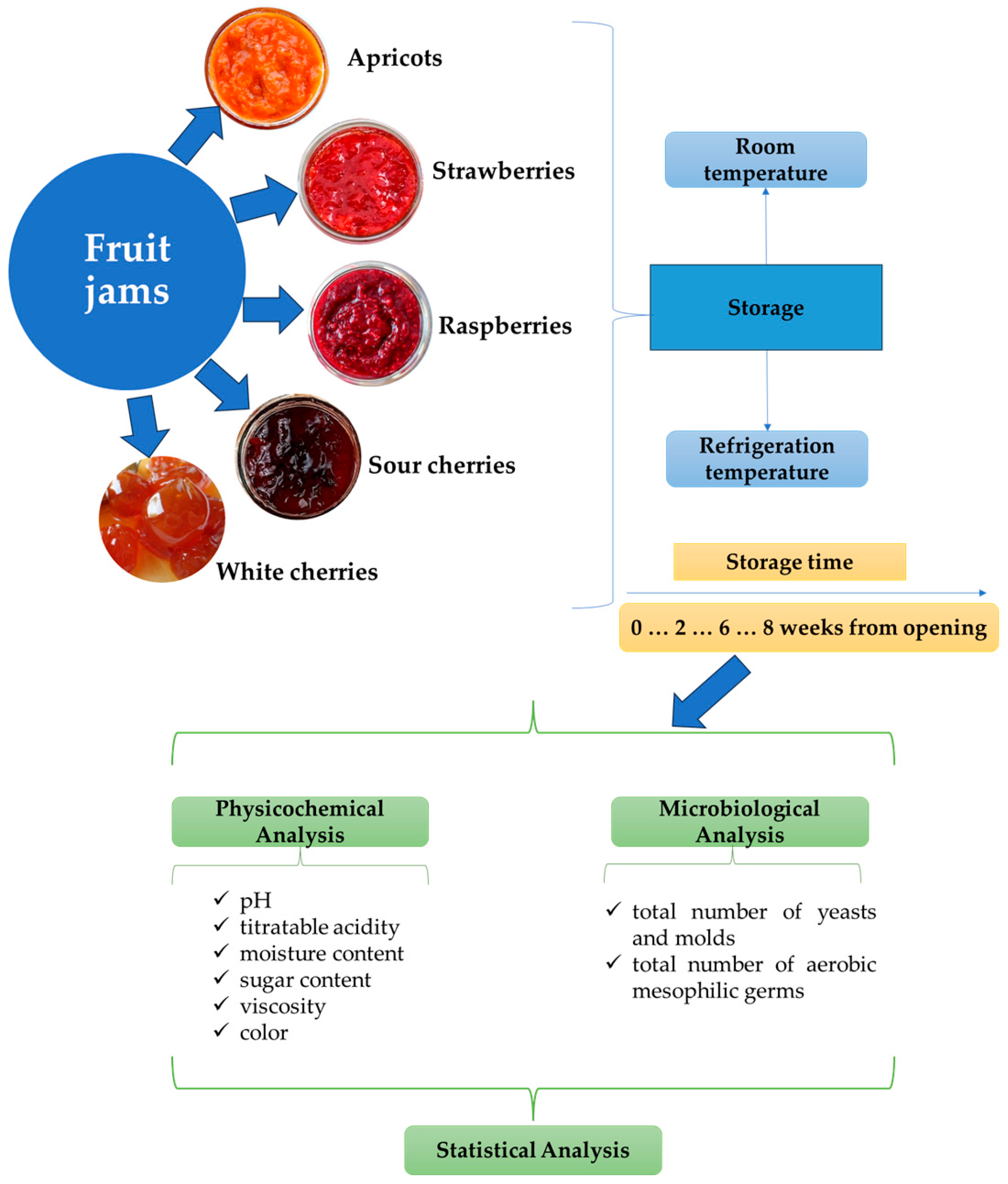
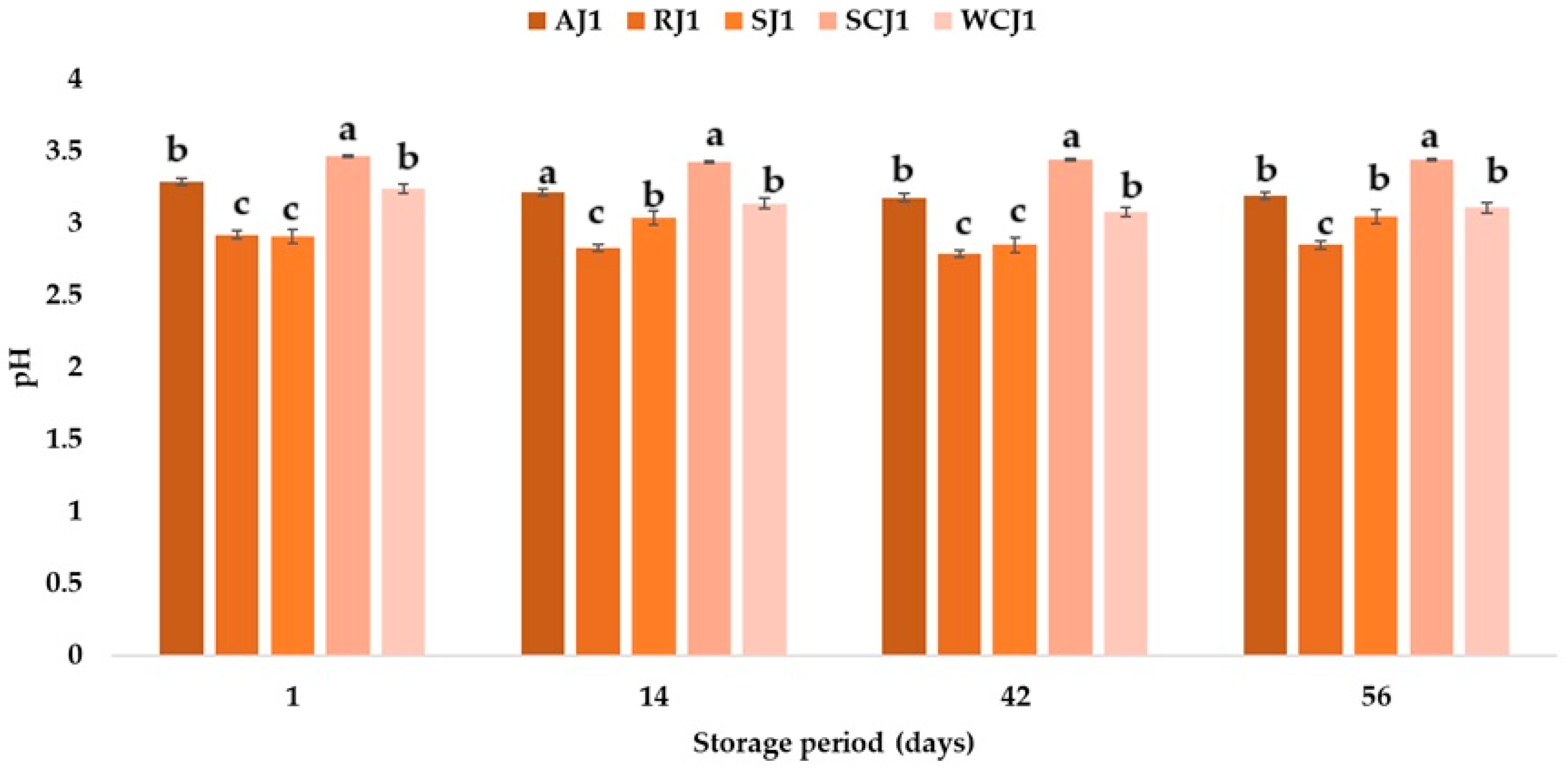
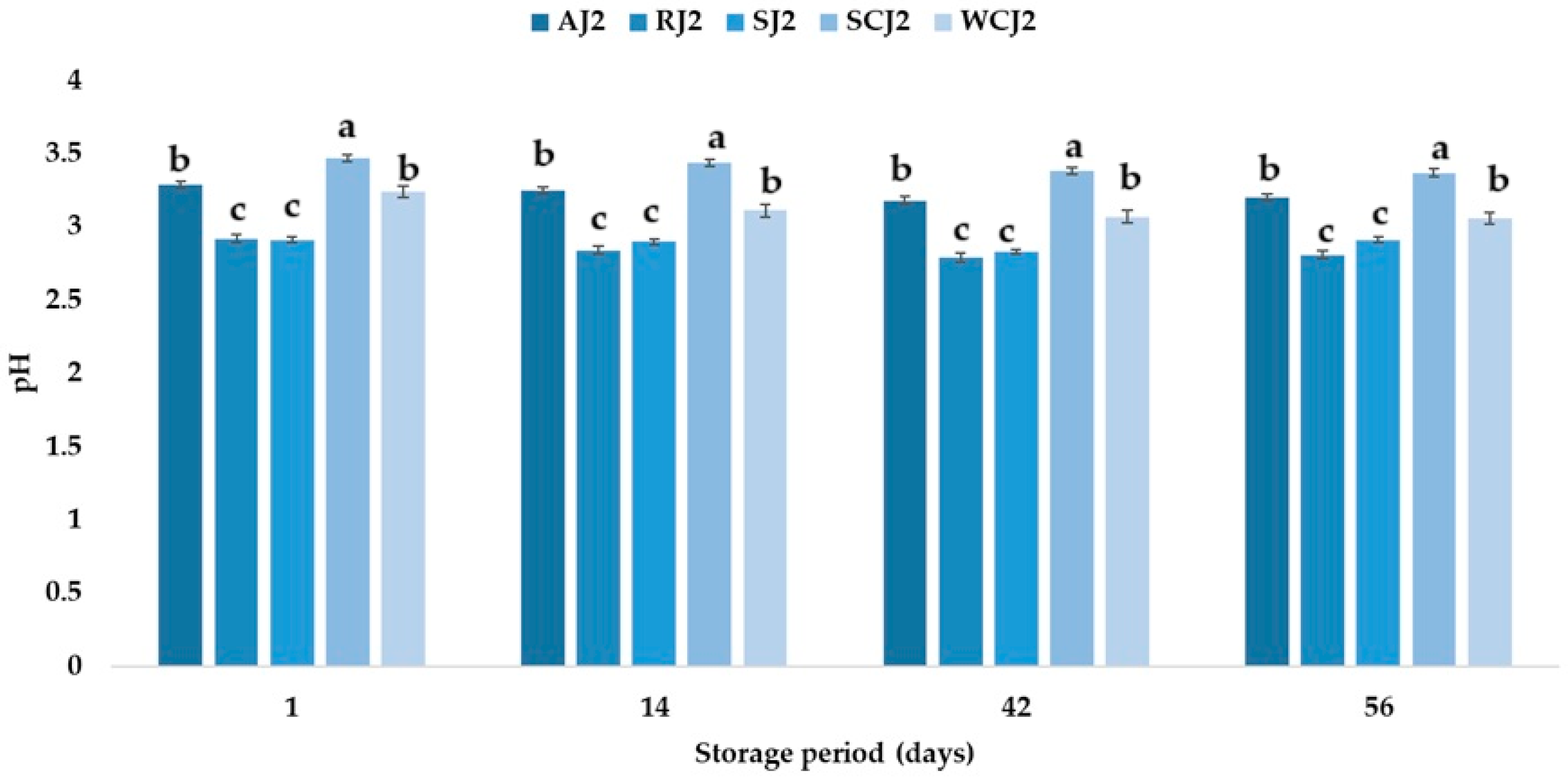
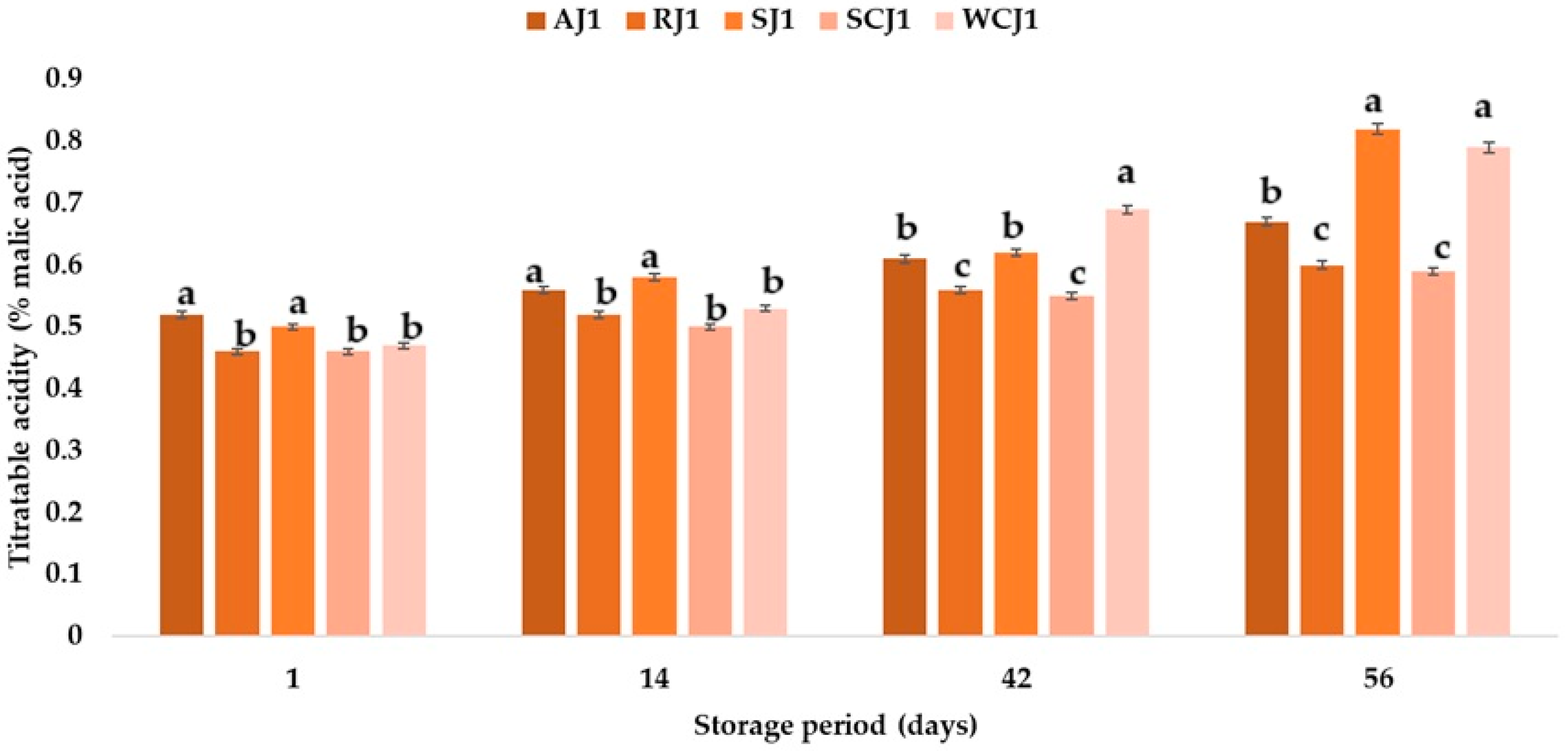
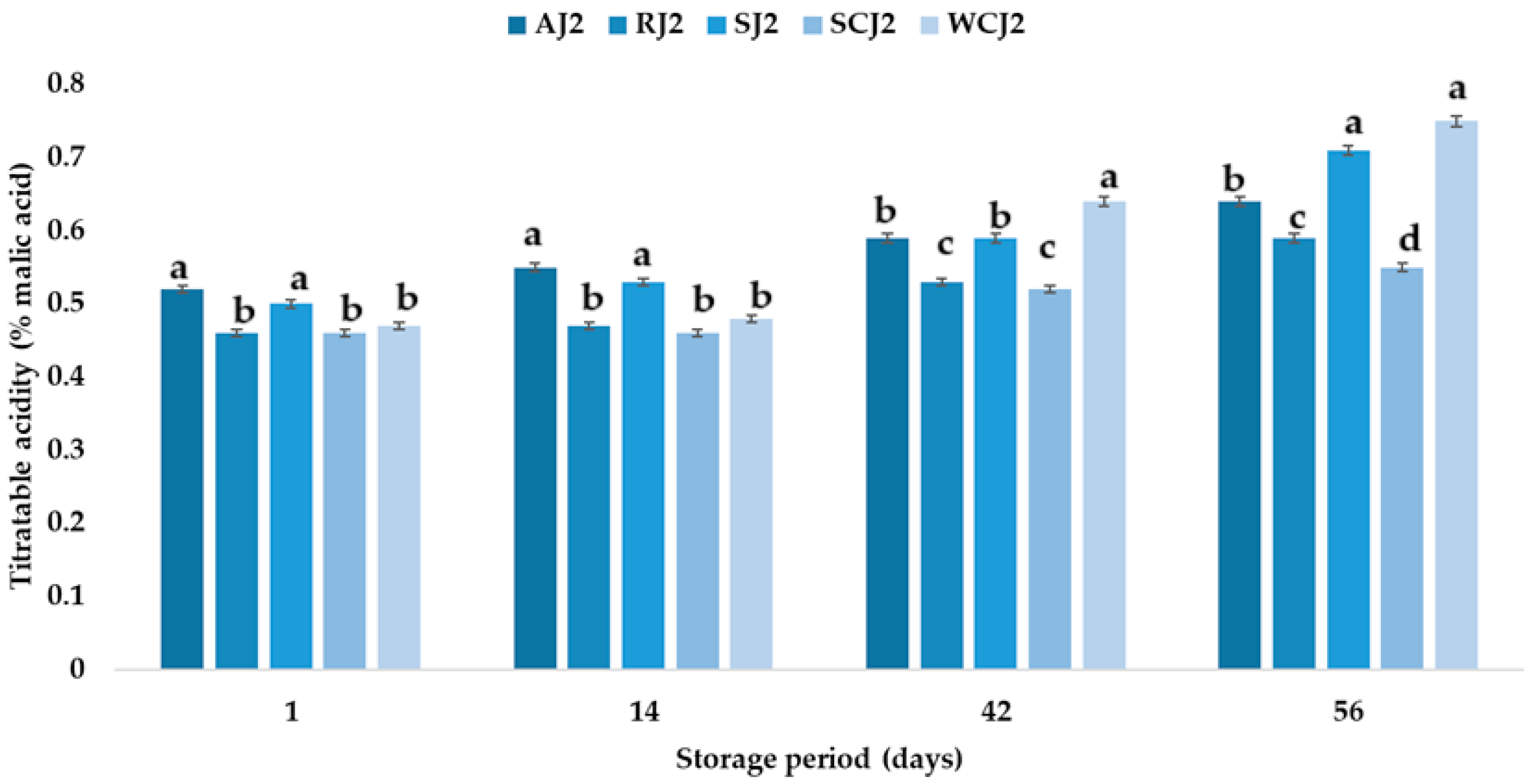





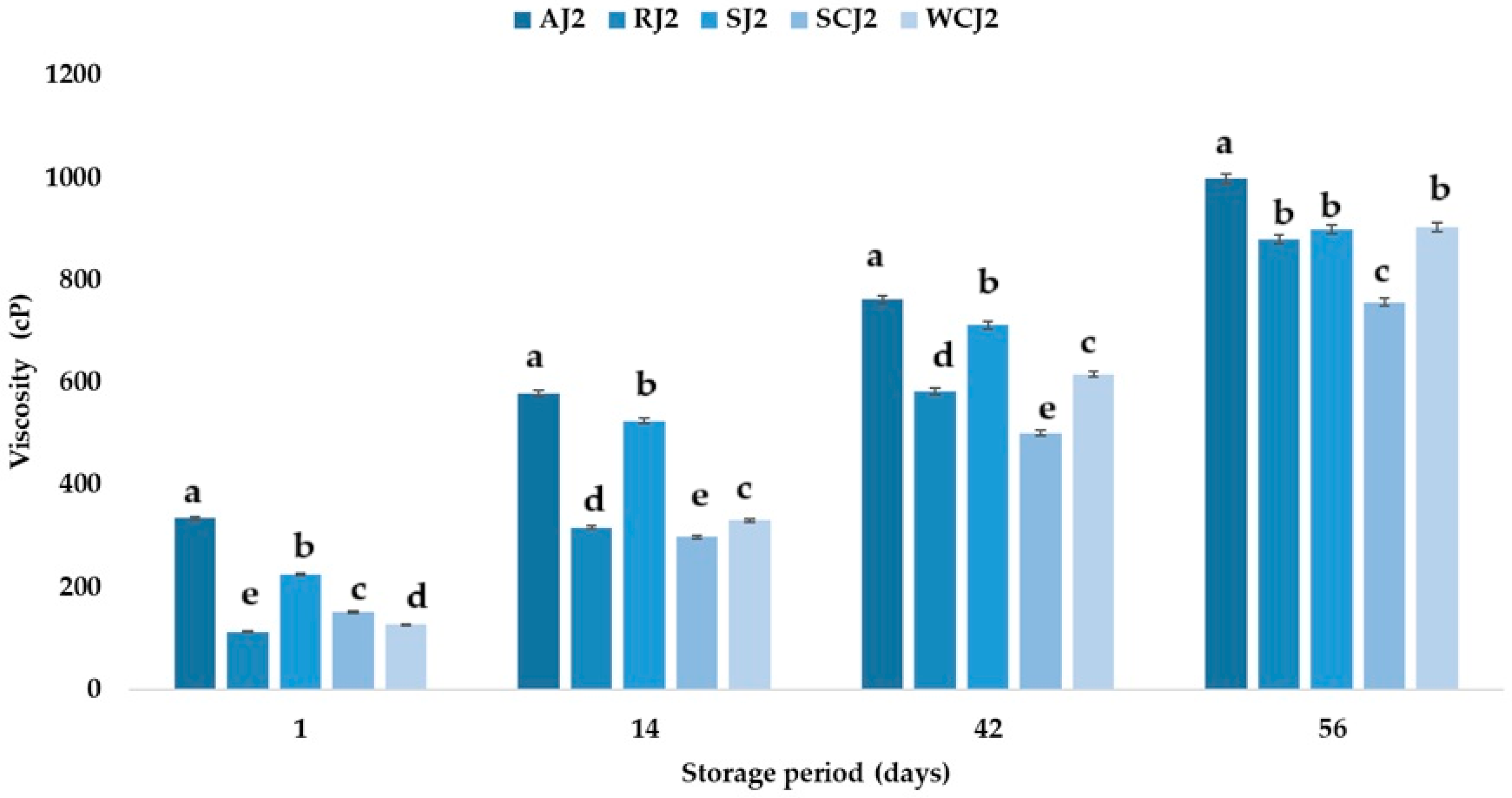

| Fruit Jams | Producer Specifications | Nutritional Values Declared by the Producers |
|---|---|---|
| Apricot jam | Ingredients: apricots, sugar, glucose syrup; acidifier: citric acid; gelling agent: pectin. Product prepared with 65 g of fruit per 100 g of finished product. | Energy value: 274 kcal/100 g Carbohydrates: 67 g/100 g Fiber: 1.4 g/100 g Protein: 0.5 g/100 g |
| Strawberry jam | Ingredients: strawberries (65%), sugar, glucose–fructose syrup, gelling agent (pectin), acidifier (citric acid). | Energy value: 263 kcal/100 g Fat: 0.1 g/100 g Carbohydrates: 65 g/100 g Fiber: 0.1 g/100 g Sodium: 0 g/100 g Protein: 0.5 g/100 g |
| Raspberry jam | Ingredients: raspberries, sugar, glucose syrup; acidifier: citric acid; gelling agent: pectin. Product prepared with 65 g of fruit per 100 g of finished product. | Energy value: 263 kCal/100 g Fat: 0 g/100 g Carbohydrates: 63.3 g/100 g Protein: 1.5 g/100 g |
| Sour cherry jam | Ingredients: sour cherries, glucose–fructose syrup, sugar; gelling agent: pectin; acidifier: citric acid. | Energy value: 264 kCal/100 g Fat: 0.4 g/100 g Carbohydrates: 65 g/100 g Protein: 0.8 g/100 g Salt: 0 g/100 g Fiber: 0.07 g/100 g |
| White cherry jam | Ingredients: white cherries, sugar; acidifier: citric acid. Product prepared with 45 g of fruit per 100 g of finished product. | Energy value: 299 kCal/100 g Fat: 0.1 g/100 g Carbohydrates: 73 g/100 g Protein: 0.5 g/100 g Salt: 0 g/100 g Fiber: 0 g/100 g |
| Sample Name | Sample | L* | a* | b* | ΔE |
|---|---|---|---|---|---|
| Strawberry jam (1st day) | SJ | 20.06 ± 0.50 f | 3.49 ± 0.31 d | 4.11 ± 0.10 e | - |
| Strawberry jam (14th day) | SJ1 | 20.36 ± 0.39 ef | 10.39 ± 0.43 a | 7.74 ± 0.29 b | 7.82 ± 0.24 c |
| SJ2 | 21.44 ± 0.20 e | 6.04 ± 0.08 c | 5.27 ± 0.03 d | 3.12 ± 0.13 e | |
| Strawberry jam (42th day) | SJ1 | 20.74 ± 0.41 c | 1.20 ± 0.20 e | 3.39 ± 0.10 f | 5.26 ± 0.46 d |
| SJ2 | 29.44 ± 0.42 a | 3.89 ± 0.13 d | 5.94 ± 0.23 cd | 9.56 ± 0.46 b | |
| Strawberry jam (56th day) | SJ1 | 20.70 ± 0.43 d | 7.90 ± 0.64 b | 6.25 ± 0.37 c | 5.59 ± 0.61 d |
| SJ2 | 27.82 ± 0.82 b | 8.14 ± 0.42 b | 10.24 ± 0.38 a | 10.94 ± 0.42 a | |
| Sour cherry jam (1st day) | SCJ | 21.10 ± 0.48 abc | −0.11 ± 0.40 a | 2.63 ± 0.11 bc | - |
| Sour cherry jam (14th day) | SCJ1 | 21.52 ± 1.21 abc | 0.28 ± 0.24 a | 2.66 ± 0.08 abc | 1.51 ± 0.35 a |
| SCJ2 | 17.80 ± 3.14 c | −0.26 ± 0.14 a | 3.10 ± 0.23 ab | 3.37 ± 3.58 a | |
| Sour cherry jam (42th day) | SCJ1 | 20.17 ± 1.55 abc | 0.28 ± 0.14 a | 3.15 ± 0.05 a | 1.88 ± 0.51 a |
| SCJ2 | 25.21 ± 0.28 a | −0.14 ± 0.08 a | 2.52 ± 0.01 c | 4.13 ± 0.20 a | |
| Sour cherry jam (56th day) | SCJ1 | 20.03 ± 2.88 bc | 0.43 ± 0.66 a | 2.88 ± 0.39 abc | 1.87 ± 2.03 a |
| SCJ2 | 23.66 ± 1.37 ab | −0.28 ± 0.07 a | 2.50 ± 0.03 c | 2.61 ± 1.83 a | |
| Apricot jam (1st day) | AJ | 33.21 ± 0.28 bc | 3.58 ± 0.24 cd | 17.89 ± 0.90 cd | - |
| Apricot jam (14th day) | AJ1 | 32.55 ± 0.61 c | 4.31 ± 0.20 ab | 14.66 ± 0.44 e | 3.49 ± 0.42 ab |
| AJ2 | 35.97 ± 0.51 a | 3.39 ± 0.08 d | 19.25 ± 0.08 bc | 3.15 ± 0.60 ab | |
| Apricot jam (42th day) | AJ1 | 35.69 ± 1.01 a | 4.47 ± 0.06 a | 19.64 ± 0.75 b | 3.32 ± 0.67 ab |
| AJ2 | 36.23 ± 0.18 a | 2.86 ± 0.03 e | 17.52 ± 0.20 d | 3.19 ± 0.56 ab | |
| Apricot jam (56th day) | AJ1 | 34.94 ± 0.58 ab | 3.99 ± 0.19 bc | 17.04 ± 0.38 d | 2.10 ± 0.99 b |
| AJ2 | 31.55 ± 0.98 c | 4.67 ± 0.14 a | 22.72 ± 0.56 a | 5.28 ± 1.63 a | |
| Raspberry jam (1st day) | RJ | 23.31 ± 0.16 f | 6.06 ± 0.05 a | 5.95 ± 0.03 d | - |
| Raspberry jam (14th day) | RJ1 | 26.19 ± 0.35 bc | 5.04 ± 0.12 b | 5.52 ± 0.01 e | 3.09 ± 0.50 b |
| RJ2 | 29.36 ± 0.46 a | 3.59 ± 0.24 c | 5.86 ± 0.19 d | 6.54 ± 0.44 a | |
| Raspberry jam (42th day) | RJ1 | 24.94 ± 0.27 de | 6.12 ± 0.22 a | 6.82 ± 0.06 ab | 1.86 ± 0.28 c |
| RJ2 | 26.55 ± 0.26 b | 4.82 ± 0.13 b | 6.63 ± 0.07 bc | 3.54 ± 0.42 b | |
| Raspberry jam (56th day) | RJ1 | 25.62 ± 0.20 cd | 6.46 ± 0.06 a | 6.91 ± 0.03 a | 2.53 ± 0.33 bc |
| RJ2 | 24.59 ± 0.38 e | 4.83 ± 0.24 b | 6.49 ± 0.15 c | 1.88 ± 0.18 c | |
| White cherry jam (1st day) | WCJ | 16.47 ± 1.19 e | 6.63 ± 0.11 a | 15.10 ± 0.56 b | - |
| White cherry jam (14th day) | WCJ1 | 37.84 ± 0.32 a | 3.59 ± 0.12 c | 26.57 ± 0.57 a | 24.46 ± 1.28 a |
| WCJ2 | 38.76 ± 0.17 a | 2.61 ± 0.06 d | 26.03 ± 0.26 a | 9.64 ± 2.42 b | |
| White cherry jam (42th day) | WCJ1 | 25.78 ± 1.02 cd | 6.30 ± 0.31 a | 12.75 ± 0.90 c | 13.69 ± 1.45 b |
| WCJ2 | 27.19 ± 0.52 bc | 6.71 ± 0.06 a | 12.73 ± 0.23 c | 25.16 ± 1.07 a | |
| White cherry jam (56th day) | WCJ1 | 29.16 ± 0.32 b | 4.82 ± 0.39 b | 10.34 ± 0.11 d | 10.98 ± 1.82 b |
| WCJ2 | 23.65 ± 2.44 d | 3.62 ± 0.04 c | 7.54 ± 0.38 e | 11.03 ± 2.77 b |
| Storage Day | Sample | Total Number of Yeasts and Molds (TYM) | |
|---|---|---|---|
| Day 1 | AJ | 0.00 | |
| RJ | 3.95 ± 0.01 b | ||
| SJ | 3.95 ± 0.00 b | ||
| SCJ | 0.00 | ||
| WCJ | 4.25 ± 0.03 a | ||
| Day 14 | Room temperature | Refrigeration temperature | |
| AJ | 4.95 ± 0.05 c | 4.56 ± 0.06 a | |
| RJ | 4.95 ± 0.07 c | 4.26 ± 0.05 b | |
| SJ | 5.43 ± 0.05 b | 4.56 ± 0.06 a | |
| SCJ | 5.86 ± 0.01 a | 3.95 ± 0.04 c | |
| WCJ | 4.95 ± 0.05 c | 3.95 ± 0.04 c | |
| Day 42 | AJ | 5.95 ± 0.01 c | 5.76 ± 0.07 c |
| RJ | 6.26 ± 0.03 b | 5.95 ± 0.04 b | |
| SJ | 6.43 ± 0.04 a | 5.95 ± 0.04 b | |
| SCJ | 5.95 ± 0.01 c | 6.26 ± 0.05 a | |
| WCJ | 6.43 ± 0.03 a | 5.78 ± 0.07 c | |
| Day 56 | AJ | 6.79 ± 0.02 a | 5.95 ± 0.04 b |
| RJ | 6.65 ± 0.01 b | 5.95 ± 0.04 b | |
| SJ | 6.43 ± 0.06 c | 5.95 ± 0.02 b | |
| SCJ | 6.43 ± 0.05 c | 6.43 ± 0.01 a | |
| WCJ | 6.55 ± 0.03 b | 5.95 ± 0.04 b | |
| Storage Day | Sample | Total Number of Aerobic Mesophilic Germs (TAMG) | |
|---|---|---|---|
| Day 1 | AJ | 4.65 ± 0.03 ab | |
| RJ | 4.73 ± 0.02 a | ||
| SJ | 4.56 ± 0.06 b | ||
| SCJ | 4.73 ± 0.01 a | ||
| WCJ | 3.95 ± 0.04 c | ||
| Day 14 | Room temperature | Refrigeration temperature | |
| AJ | 6.46 ± 0.01 a | 5.21 ± 0.01 a | |
| RJ | 6.45 ± 0.05 ab | 5.32 ± 0.05 a | |
| SJ | 6.28 ± 0.06 c | 4.95 ± 0.04 b | |
| SCJ | 6.35 ± 0.02 bc | 5.32 ± 0.06 a | |
| WCJ | 6.43 ± 0.01 ab | 5.30 ± 0.06 a | |
| Day 42 | AJ | 7.97 ± 0.06 a | 6.43 ± 0.01 d |
| RJ | 7.00 ± 0.01 c | 6.91 ± 0.02 b | |
| SJ | 7.26 ± 0.05 b | 6.86 ± 0.03 b | |
| SCJ | 6.65 ± 0.03 d | 7.07 ± 0.01 a | |
| WCJ | 7.26 ± 0.02 b | 6.56 ± 0.05 c | |
| Day 56 | AJ | 9.20 ± 0.04 b | 7.65 ± 0.03 b |
| RJ | 9.29 ± 0.07 b | 7.65 ± 0.02 b | |
| SJ | 9.43 ± 0.02 a | 9.28 ± 0.04 a | |
| SCJ | 8.82 ± 0.01 c | 9.31 ± 0.01 a | |
| WCJ | 8.55 ± 0.04 d | 9.34 ± 0.03 a | |
Disclaimer/Publisher’s Note: The statements, opinions and data contained in all publications are solely those of the individual author(s) and contributor(s) and not of MDPI and/or the editor(s). MDPI and/or the editor(s) disclaim responsibility for any injury to people or property resulting from any ideas, methods, instructions or products referred to in the content. |
© 2025 by the authors. Licensee MDPI, Basel, Switzerland. This article is an open access article distributed under the terms and conditions of the Creative Commons Attribution (CC BY) license (https://creativecommons.org/licenses/by/4.0/).
Share and Cite
Prisacaru, A.E.; Ghinea, C.; Albu, E.; Pădureţ, S. Storage Impact on the Physicochemical and Microbiological Stability of Apricot, Cherry, Raspberry, and Strawberry Jams. Foods 2025, 14, 1695. https://doi.org/10.3390/foods14101695
Prisacaru AE, Ghinea C, Albu E, Pădureţ S. Storage Impact on the Physicochemical and Microbiological Stability of Apricot, Cherry, Raspberry, and Strawberry Jams. Foods. 2025; 14(10):1695. https://doi.org/10.3390/foods14101695
Chicago/Turabian StylePrisacaru, Ancuta Elena, Cristina Ghinea, Eufrozina Albu, and Sergiu Pădureţ. 2025. "Storage Impact on the Physicochemical and Microbiological Stability of Apricot, Cherry, Raspberry, and Strawberry Jams" Foods 14, no. 10: 1695. https://doi.org/10.3390/foods14101695
APA StylePrisacaru, A. E., Ghinea, C., Albu, E., & Pădureţ, S. (2025). Storage Impact on the Physicochemical and Microbiological Stability of Apricot, Cherry, Raspberry, and Strawberry Jams. Foods, 14(10), 1695. https://doi.org/10.3390/foods14101695







